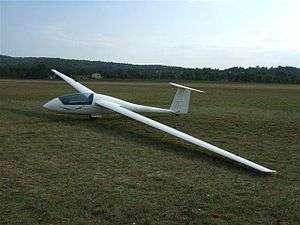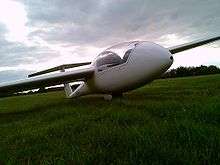Schempp-Hirth Standard Cirrus
| Cirrus | |
|---|---|
 | |
| Role | Standard-class sailplane |
| National origin | Germany |
| Manufacturer | Schempp-Hirth |
| Designer | Klaus Holighaus |
| First flight | 02 / 20 / 1969 |
| Number built | ca. 838 |
The Standard Cirrus is a German Standard-class glider built by Schempp-Hirth. The Standard Cirrus was produced between 1969 and 1985.
Development
The Standard Cirrus was designed by Dipl. Ing. Klaus Holighaus and flew for the first time in March 1969. It is a Standard Class glider with a 15-metre span and no camber-changing flaps. The all-moving tailplane, a feature of many designs of that period due to its theoretically higher efficiency, caused less than desirable high-speed stability characteristics, and so modifications were made to the early design. Even so, the glider is still very sensitive in pitch. The aircraft built before 1972 have a washout of -0.75 degrees. The washout was then increased to -1.5 degrees which improved low-speed performance and response at slow speed.[1]
Improvements were made with the Standard Cirrus 75. These included better air-brakes with an increased frontal area. By April 1977, when production by Schempp-Hirth ended, a total of 700 Standard Cirruses had been built, including 200 built under licence by Grob between 1972 and July 1975. A French firm, Lanaverre Industrie, had also built 38 Standard Cirruses under licence by 1979. VTC of Yugoslavia also licence-built Standard Cirruses, reaching approximately 100 by 1985.
All models of Cirrus have proved very popular in recent years in Club Class Competitions worldwide.
The Cirrus was superseded by the Discus in 1984.
Variants
- Cirrus B
The Cirrus B is based on the Standard Cirrus 75 but with interchangeable wingtips giving a span of either 15m or 16m.
- Cirrus K
The two Cirrus K have a reduced span (12.6m), larger ailerons, a cross tail with larger elevator, and a strengthened fuselage which make them suitable for aerobatics. This modification was initiated by Wilhelm Düerkop in the late 1980s.[2][3] Wolfgang Seitz took part in the 1995 World Glider Aerobatic Championships with a Cirrus K.[4]
- G/81
The last Cirrus model was the G/81 built by VTC until 1985. This incorporated a longer fuselage and canopy, and a conventional tailplane and elevator with the wings of the Cirrus 75.
Specifications

General characteristics
- Crew: One
- Capacity: 80 kg (176 lb) water ballast
- Length: 6.35 m (20 ft 10 in)
- Wingspan: 15.00 m (49 ft 3 in)
- Height: 1.32 m (4 ft 4 in)
- Wing area: 10.0 m2 (108 ft2)
- Aspect ratio: 22.5
- Wing profile: FX S-02-196 modified
- Empty weight: ca. 215 kg (473 lb)
- Gross weight: 390 kg (860 lb)
Performance
- Maximum speed: 220 km/h (140 mph)
- Maximum glide ratio: 38.5
- Rate of sink: 0.6 m/s (120 ft/min)
See also
Aircraft of comparable role, configuration and era
Related lists
References
| Wikimedia Commons has media related to Schempp-Hirth Standard Cirrus. |
- Schempp-Hirth Website
- Standard Cirrus Web Page
- Coates A.,Janes World Sailplanes and Motor Gliders, Janes,1980, ISBN 0-7106-0017-8, pg. 85
- Simons M, Segelflugzeuge 1965-2000, Eqip, 2004
- Sailplane Directory
- American narrative of World Championships (see 1968).